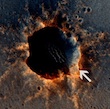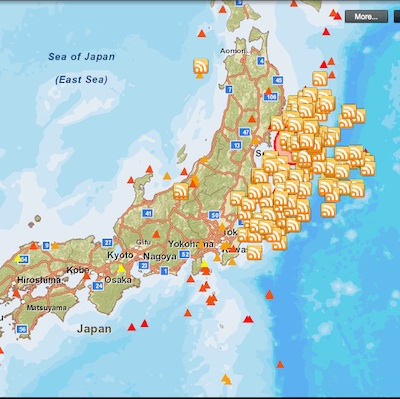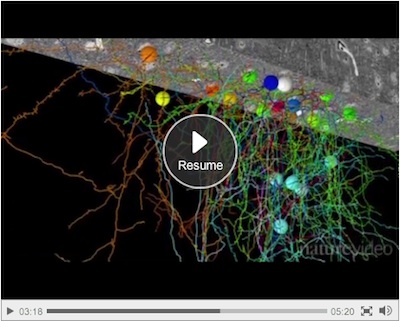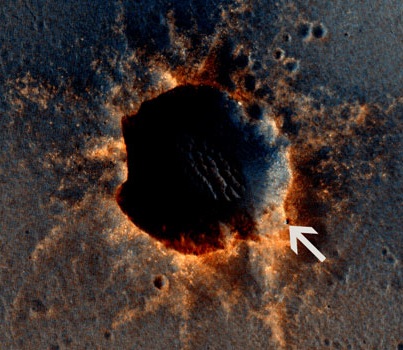 View Japan quake aftershocks in near-real-time, watch the light show at Kilauea volcano, make a map of the brain, and interact with a Data-like android. All this and more in this week’s Science Saturday!
View Japan quake aftershocks in near-real-time, watch the light show at Kilauea volcano, make a map of the brain, and interact with a Data-like android. All this and more in this week’s Science Saturday!
Near-Real-Time Map of Japan Quake Aftershocks
The 8.9 magnitude earthquake that struck Japan this week has continued to shake the country with aftershocks. Researchers at Texas Tech’s Center for Geospatial Technologies have created a near-real-time map of aftershock earthquakes, accessible on the web. The map was developed after scientists notices a lack of information being presented on major news outlets. “It provides map information, satellite imagery and location of recent earthquakes. As part of this major earthquake, there are hundreds of aftershocks that follow.”
See the earthquake map live at mapserver.gis.ttu.edu/japanquake/

See the live earthquake map
Mount Kilauea Living Up to its Fiery Reputation
Mount Kilauea in Hawaii, whose name means “spewing” or “spreading” in Hawaiian, is one of the most active volcanoes in the world and has been giving onlookers quite a show lately. Throughout January and February, it has been rumbling and crater walls have been collapsing. On 3 March, a dramatic collapse at Halema’uma’u shows part of the vent wall falling into the lava lake. Erupting fissures were filmed in early March, sending lava up to 10 meters into the air. According to US Geological Survey (USGS), a lake of lava about 200 meters deep has formed inside one of the craters, while seismic activity in the area remains high. New reports estimate that 150 detectable earthquakes have been caused by the eruption, although so far it poses no threat to locals. The time-lapse is a compilation of videos shot by the (USGS) from a variety of cameras between 15 February and 6 March 2011. (via New Scientist)
Untangling the Brain
Knowing how the tangle of billions of nerve cells in the brain are connected will be key to understanding how we see and dream — and how to repair the brain when something goes wrong. In a first step, scientists have mapped the wiring in part of the mouse brain and related it to how the animal sees. (via Guardian Science)

Click to watch at The Guardian
New Amazingly Life-like Android Better than Data?
Some are claiming that Geminoid DK, a new android built by the Intelligent Robotics lab at Osaka University and designed by professor Hiroshi Ishiguro, might be even more lifelike than Brent Spiner’s Data. Just like Data was modeled after his creator Doctor Noonian Soong, the Geminoid DK is created in the likeness of professor Henrik Scharfe of Aalborg University in Denmark. “All of the movements and expressions of Geminoid DK are remote controlled by an operator with a computer, who uses a motion-capture system that tracks facial expressions and head movements. Turn your head and the Geminoid does the same; move your mouth and the android follows suit,” IEEE Spectrum reports. (via Universe Today)
Pic of the Week: Opportunity at Santa Maria Crater
The High Resolution Imaging Science Experiment (HiRISE) camera on NASA’s Mars Reconnaissance Orbiter acquired this beautiful color image on March 9, 2011, of “Santa Maria” crater, showing NASA’s Mars Exploration Rover Opportunity perched on the southeast rim.

Click for full image
Image credit: NASA/JPL-Caltech/Univ. of Arizona
Science Bytes
Not enough science for you? Here’s a warp-speed look at some more science tid-bits that are worth a peek.
- The next mission to Mars soon to be decided, based on decadal-survey committee recommendations
- Half-Time for the Mars500

I think that Mother Nature is making her views about humanity known — more and more strongly — as the years go on.
Just Increadable what is happening over in Japan. I love the Real time map on the Earth quakes. Mount Kilauea is an Impressive Volcano. I visited there many times when I was in the navy in Hawaii. But it is even more Impressive now.
Being honest….I don’t think mother nature has an opinion.
My thoughts go out to all those affected by the events in Japan.
Re 1: … but seaquakes and the resulting Tsunamis are not the result of pollution or of any other human-made cause.
The situation is different with disasters caused by extreme weather conditions (e.g. hurricanes). These can be blaimed on global warming.
3 and 4, in some sense I am a believer in karma, even though not “officially” so. What goes around, comes around.
I’m being somewhat facetious in anthropomorphizing nature, admittedly, and yet I am reminded of human frailties at times like these. If only we as a planet were to spend even a tiny fraction of our defense budgets on ways to mitigate the potential for disaster, so much untold suffering could alleviated. Instead of reacting to nature, we could prevent the harm that comes from catastrophes.
I’m not seriously suggesting that we are responsible for nature’s dispassionate, unfeeling, unknowing destruction of that for which we care. But I am suggesting, instead, that in a cold universe in which we are the only known technologically advanced species, and to quote Terminator 2, there is no fate but what we make.
That “Untangling the Brain” comes from ‘my’ institute, in parts ;)
Wow, the look and the expressions of the geminoid are amazing!
Kayla, I just wrote a paper about crowdsourcing major disasters for my Spatial Analysis class. I’d be happy to share it with you if you’d like.
It’s truly amazing what Google, Facebook, and Twitter have allowed geospatial analysts to do with information.
Untangling the brain is fascinating. But that Gemi-bot is freaking crazy.
And even more crazy, how long before we can digitize and re-create a real working brain/mind ? It seems only logical that those two projects would eventually intersect. One would provide the hardware and the other the software to literally replicate a person.
That android is incredible! All they have to do now is put that head on a (larger) Asimo body, give it IBM Watson’s brain, the strength of Raytheon’s “Iron Man” suit, and we’re one big step closer to having a real Commander Data… or The Terminator, depending on which way you’re bent.
Well the Japanese were pretty good at disaster mitigation, but that only goes so far. I think it’s ridiculous how people extrapolate from the safety of their tiny well protected lives that they are safe in the world or nature. Earth is disaster prone. Plain and simple. Always was. Always will be. Disaster preparedness should be a way of life, but instead most of us prepare for the best and hope for the best and so are unready when severe disaster strikes. Worst part is we teach the new generations to live profligate lives so that even if OUR generation avoids catastrophe, we habituate the future to live the same way, and some of those generations will face catastrophe, and they won’t know how to cope. If there was a series of well placed EMP strikes, for example, or even if we got directly hit with a CME induced geomagnetic storm that takes down our energy infrastructure, a LOT of people actually believe that the government is going to be able to rescue them, and they will die thinking that. It’s one thing when a small area is hit and people can relocate to the affected areas from unaffected areas to help, which happens to be the unfortunate assumption behind our emergency response planning. It’s something else when all the areas are equally affected. We aren’t prepared for that scenario on a national level.
In fact, people would rather not even think about it. It’s not happy talk.
A hundred years ago we still knew how to live without electricity. It’s sudden elimination would not have unraveled the fabric of society. Today? Nearly EVERYthing we do depends on it, from water purification, food storage, communication, construction, manufacturing, financial transactions, you name it. It is our Achilles Heel. You take down our power and our society unravels.
At the same time, how many of us today wouldn’t have known about the Japanese earthquake even today without electricity and the Internet? How many people owe their lives to electricity? Its a double edged sword.
I agree with dmduncan. The first-world western society have become so dependent on electricity that is supplied, often from sources far from where we are. Some people try to be self-sufficient but that can be difficult and these people are often seen as luddites and cranks.
A rather smelly problem afflicting many Christchurch residents who are still able to live in their (damaged, but structurally reasonably safe) homes is that of sewerage. Most of the infrastructure which dealt with sewerage waste has been damaged beyond repair – what the first quake didn’t do, the second one did. Civil defence and other agencies are instructing people on who to build the good ol’ fashioned longdrop toilet in their back yards.
Water is on for 90% of Christchurch but all of it requires boiling. Electricity is similar, I think.
One of the television channels have run a competition to find out which person/family had the best looking, neatest, most unusual, functional longdrop. People sent photos in by phone.
Christchurch is a relatively small modern city with a small population – nothing compared to the populations of Los Angeles, New York etc. Yet it is estimated that it will take around NZ$16 biilion to properly rebuild the city, house everybody again etc. Scary stuff. I think that for a lot of people this sort of knowledge is hard to get their heads around. It certainly is for me.
Cities like Los Angeles are even older and although I suspect a good deal of the city has a modern infrastructure – water piping and reticulation, electricity supply, sewerage waste water treatment etc, an earthquake of the size of the second one that hit Chch (6.3 on the richter scale) hitting that city would cause way more damage, depending on where the epicentre was. Loss of life and injuries would be greater too. To use a common technical phrase in these parts, things would be pretty much munted. Scary times, as if they haven’t always been, of course.
2010 was a record year for natural disasters. The third largest earthquake in recorded history hit Indonesia at the end of 2004. This recent quake in Japan is the fifth biggest ever. The tsunamis involved in both disasters also register as some of the biggest ever recorded. Plus there were devasting earthquakes in Iran, Pakistan, New Zealand, and Chile.
While there is no direct connection between earthquakes and global warming, there is still the possibility that we are partially responsible for the rise in the number and severity of earthquakes and tsunamis. I suspect that many scientists will do studies and may find that the trend towards more severe and more frequent disasters is a very frightening possibility.
The big worry is that an earthquake that is so powerful will occur that it cannot be registered on the Richter scale and may wipe out entire cities and even small countries and islands. Millions will perish. And if a big enough fissure opens on the ocean floor, cold sea water would fall into the mantle, with the water instantly turning into flash steam, and resulting in a massive explosion that would destroy the Earth.
Just something to think about when you go to bed.
fantastic articles love this stuff
all i can say is wow
I think my reaction to the android is similar to what I see my cats do when I put a stuffed animal with a voice box in their midst. They walk around it and sniff, knowing it’s “kinda like a cat” but not quite. It is getting way too close for comfort, though. Gonna get interesting as we approach singularity.
Great stuff, Kayla.
@15 O_o…thanks for the nightmares…
18, I am trying to picture that scenario in my mind. It must be quite a sight and I wonder what happens when the cats think about the experience after a nice nap or the next day. Was it ever real, they might think? Was it just some sort of bizarre dream?
— Ah, the sound of a can opener … food! Never mind!
Okay, that android looks like a human. If it can operate without human control, you’rve got something. Just make sure Skynet doesn’t get a hold of it. :-)
19
Just think of it as a potential free (albeit one-way) trip into space! :-)
14. keachick – March 12, 2011
Goggle Northridge Earthquake. Occured in 1994, magnitude 6.7. The largest quake to occur on the San Andreas fault zone was a 7.9, and most codes in CA take that into account. Anyway, looking at the Northridge quake can give you a good idea what you might be looking at on the San Andreas when that event occurs. Most disaster prepardness experts tell us to plan on being on our own for the first 48 hours, and if the Federal response to Katrina is any kind of an example, we need to figure on it actually being more like a week.
23. Phil – March 13, 2011
I watched a British seismologist on TV yesterday, speaking from CA. He said they expect CA to get hit with a 9.0 magnitude quake sometime in the next 10 to 100 years. But he really can’t predict when the earth is going to release that kind of quake. It could happen next week, for all anybody knows. So the same type of event that just happened in Japan will happen on the west coast of America. And what the Japanese are dealing with right now is what many Californians will have to deal with then. That is what you have to be ready for. 30 minutes after the tsunami alarms went off in Sendai, many of its residents were caught on the jammed roads out when the water moved in.
You must think ahead. Plan on being on your own for a month, and plan on being able to help others who were not so well prepared. Much better to over than underestimate.
Better yet, MOVE while you still have the time.
@6 NCC-73515 Wow! Which is ‘your’ institute? Are you in neuroscience or biology?
@8 That One Guy That sounds great, I’d love to read your paper. A Spatial Analysis class sounds fascinating!
@12, 13, 14… I agree that we are super dependent upon technology these days, but I don’t think of it as a weakness or even an Achilles Heal of sorts. Take your example, water purification. Centuries ago, we lived without things like water purification at all. Technology has given this to us, rather than replaced an analogue tech with a digital one. As technology, science, medicine, etc increase in sophistication, go goes our life expectancy. Taking away technology would be disastrous to our MODERN way of life, but we would adapt.
@15 Red Dead Ryan While we can blame SOME natural disasters on global warming (warming of the oceans causes more intense hurricanes, for example), I believe that the recent perception that natural disasters on the whole occur MORE OFTEN than in the past is a misconception. The difference is that the disasters are occurring in populated areas and that the information is being disseminated more quickly than ever before.
I’m not saying you’re wrong, I’m just saying that I don’t think there is any current evidence linking plate tectonics to changes in the Earth’s overall temperature.
Oh, but that bit at the end about water flash steaming into the mantle… pretty sure we don’t have to worry about that!! See: Mid-Ocean Ridge.
You’re right! Everyone knows that natural disasters have never, ever happened before throughout the centuries that Earth has existed!
Oops…forgot to make it clear that my comment was directed at Post #1.
26. Kayla Iacovino – March 14, 2011
I’m not suggesting anybody go back to living in the bad ole days. In a disaster I actually have the ability to purify my own water if necessary which is something the vast majority of people are incapable of doing, and I have critical hardware safely stored in Faraday cages. So if the worst happens and I survive it, I plan on still being relatively high tech. We are extremely dependent on fragile technologies, interdependent infrastructures where a failure of one leads to cascading failures in the rest. It’s our implementation strategies that are extremely vulnerable, and we have no backup plans for the rare but very possible major disaster, whether it’s something natural like the Carrington Event, or larger, or a nationwide intentional assault on our energy infrastructure. We’ve built our infrastructure as if we are impervious to the worst of what is possible. We have built for the best and hope for the best, which is exactly the opposite of my own attitude, which is to prepare for the worst and hope for the best.
The earthquake shifted the earth’s axis and moved Japan closer to the United States.
http://news.yahoo.com/s/yblog_thelookout/20110314/ts_yblog_thelookout/japans-earthquake-shifted-balance-of-the-planet
I mean, the probability that a disaster is NOT going to happen may be very high until the moment when it happens unexpectedly and the probability drops to zero. If we were talking on Thursday about the likelihood of a 9.0 earthquake hitting Japan on Friday, we would probably say the odds were against it.
And we’ll be making that same argument the day before a 9.0 hits CA.
Technological dependence or no, mother nature wreck’s havoc.
The largest human disaster in history is still “the black death”, pre-technological dependence.
…And “being one with nature” sure didn’t defend the various Indigenous populations of the world from her (with lotsa help from people, of course).
Preparedness is always a wise thing, but believing there is anything one can always do to prevent mother nature from just randomly destroying everything in your world is the height of arrogance.
No, you can’t ALWAYS prepare, which isn’t an excuse not to prepare at all. In the context of talking about mitigating suffering however, preparation is an excellent idea. And nothing says we can’t be both technologically advanced AND one with nature.
Regarding dependence on technology — we’re toolmaking animals. It’s part of who we are. And even the outhouses Keachick was talking about are still technology. Not as convenient as having flushable toilets in your home, but easy to make, easy to remake, and very robust, if not as sophisticated.
The technologies that our lives now depend on are vastly interwoven — and delicate. And yet as delicate as they are, they are expected to support the weight of our entire society, which they do well, until the highly improbable event for which they were never designed to cope with happens.
I think my question is personally, as a family, where we should focus our energies in trying to be prepared if or when a disaster occurs. Apparently, if you live in Auckland, NZ, as I do, the biggest threat could be volcanic in nature. Auckland is home to at least 60 volcanoes. Most are small and extinct but there are about a dozen that are dormant, the largest and youngest being Rangitoto. It sits slap bang in the Waitemata Harbour and the Pinto chaps could not have missed seeing the massive green cone-shaped island from their hotel windows. They were in Auckland on 8 April 2009, promoting Star Trek and I did not even know about it…:((
I think that if Rangitoto blew, Auckland would be screwed. I doubt there would be anything left. To prepare for a smaller volcanic eruption – have lots of masks and access to a container of compressed air or oxygen cylinders. Not sure how that might work. The air and water would be contaminated. Everyone would have to stay inside, with all the windows tightly shut and wait it out.
Guess, I had better get some more containers of fresh water, tins of food, dried food, have first aid kit well stocked, batteries for torches, small gas cook top in case of power outtages. Getting fresh water could be an ongoing problem.
I have never been in any sort of disaster myself, just watched from afar. Oh for a crystal ball or two – you know, ones that are real and actually worked.
35.
…..
But how would you avoid being incinerated in a pyroclastic cloud?
(Assuming that Rangitoto is a cone-shaped mountain volcano, like Mt. St Helens)
@33
And nothing says we can’t be both technologically advanced AND one with nature.
Still won’t stop the inevitable, though.
You do the best you can to mitigate the severity and to make life afterward easier. But you can prepare rigorously and still get squished by a bus that you didn’t see coming. That’s the universe we live in.
You can’t prepare for a genuine end of world scenario. For that you pray or party.
But you can prepare for foreseeable disasters that your region is prone to suffer. You can buy an extra can of soup and put it away every time you go grocery shopping. You can do the same thing for band aids and anti-biotic salve, and batteries. You don’t have to do it all at once, and you’ll accumulate a good amount of stuff after only a few months doing a little at a time.
Well, I just store chocolate bars, cookies, potato chips and 7-Up!
Stock up on the cookies. They may make good legal tender.